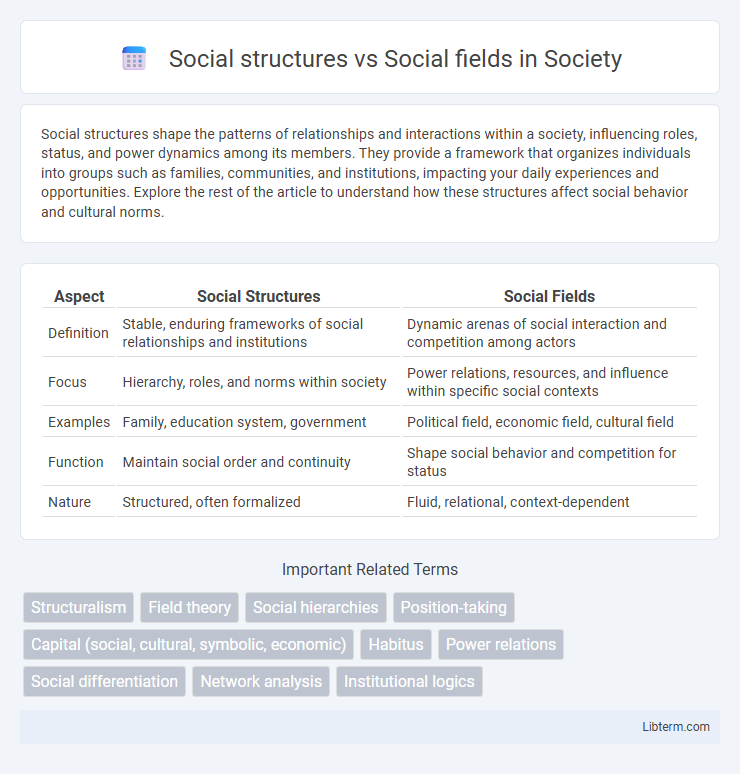Social structures shape the patterns of relationships and interactions within a society, influencing roles, status, and power dynamics among its members. They provide a framework that organizes individuals into groups such as families, communities, and institutions, impacting your daily experiences and opportunities. Explore the rest of the article to understand how these structures affect social behavior and cultural norms.
Table of Comparison
| Aspect | Social Structures | Social Fields |
|---|---|---|
| Definition | Stable, enduring frameworks of social relationships and institutions | Dynamic arenas of social interaction and competition among actors |
| Focus | Hierarchy, roles, and norms within society | Power relations, resources, and influence within specific social contexts |
| Examples | Family, education system, government | Political field, economic field, cultural field |
| Function | Maintain social order and continuity | Shape social behavior and competition for status |
| Nature | Structured, often formalized | Fluid, relational, context-dependent |
Understanding Social Structures: Definition and Core Concepts
Social structures refer to the organized patterns of relationships and institutions that shape society, encompassing roles, norms, and hierarchies fundamental to social order. Core concepts include social institutions such as family, education, and government, which establish frameworks for behavior and interactions. Understanding social structures involves analyzing these enduring systems that influence individual and group behavior across time and culture.
Exploring Social Fields: Meaning and Characteristics
Social fields represent dynamic arenas of interaction where individuals and groups continuously negotiate power, resources, and status, differing from static social structures that define fixed relationships and roles. These fields are characterized by fluidity, competition, and strategic action within boundaries shaped by historical and cultural contexts. Understanding social fields requires analyzing the intersecting forces that influence social positions and the ongoing struggles for dominance and legitimacy.
Key Differences Between Social Structures and Social Fields
Social structures refer to the enduring patterns of relationships and institutions that shape society, such as family systems, class hierarchies, and legal frameworks, while social fields are dynamic arenas where actors interact based on power, resources, and strategic interests. Key differences include social structures being relatively stable and macro-level frameworks, whereas social fields are fluid, context-specific, and shaped by ongoing social practices and competition among agents. Understanding these distinctions aids in analyzing how societal order is maintained versus how social change and agency occur within particular contexts.
Historical Development of Social Structures and Fields
Social structures and social fields have evolved through different historical contexts, with social structures originating from anthropological studies emphasizing fixed, hierarchical patterns of relationships in societies. Social fields, a concept advanced by Pierre Bourdieu, emerged in the 20th century to analyze dynamic power relations and interactions within specific domains such as politics, education, or art. The historical development of social fields highlights the fluidity and contestation of social positions, contrasting with the relatively stable and enduring nature of traditional social structures.
Theoretical Approaches to Social Structures
Theoretical approaches to social structures emphasize the interconnected roles, norms, and institutions shaping societal organization, highlighting patterns of social relations and hierarchies. In contrast, social fields focus on dynamic spaces of interaction where actors compete for resources and influence, as conceptualized in Bourdieu's theory of fields. Understanding social structures involves analyzing systemic frameworks, while social fields concentrate on agency and power struggles within defined social arenas.
Theoretical Frameworks for Social Fields
Theoretical frameworks for social fields, particularly Bourdieu's field theory, conceptualize social fields as dynamic arenas where agents and institutions compete for capital, power, and influence, contrasting with static social structures that emphasize fixed hierarchies and enduring roles. Social fields highlight the relational and contested nature of social life, focusing on the interplay of positions, strategies, and symbolic power within specific domains such as art, politics, or education. This approach provides a nuanced understanding of social interactions by integrating agency, context, and power dynamics beyond the constraints of traditional structuralist perspectives.
Interactions and Overlaps: Social Structures vs Social Fields
Social structures represent stable, overarching patterns of relationships within societies, defining roles, norms, and institutions that guide individual behavior. Social fields emphasize dynamic interactions among agents competing for resources, influence, and status within specific arenas like education, politics, or art. These concepts overlap as social fields function within the parameters set by social structures while simultaneously shaping and transforming those structures through ongoing social interactions.
Impact of Social Structures on Individual Agency
Social structures, defined as enduring patterns of social arrangements and institutions, significantly shape individual agency by providing both constraints and opportunities within which individuals operate. These structures influence behavior, access to resources, and decision-making, often determining social roles and power dynamics that affect personal freedom and choices. Understanding the impact of social structures on agency reveals how societal norms and institutions can limit or enable individuals' capacity for action and change.
Influence of Social Fields in Social Dynamics
Social fields shape social dynamics by structuring interactions based on power relations, norms, and resources within specific domains such as politics, education, or economics. The influence of social fields manifests through the distribution of capital and the strategic behavior of actors seeking to maintain or alter hierarchies. Social structures provide the broader context, but social fields offer dynamic environments where social positions and influence are actively contested and negotiated.
Future Directions in Research: Social Structures and Social Fields
Future research on social structures and social fields is increasingly focusing on the integration of digital technologies and their impact on social dynamics. Scholars prioritize examining how online platforms reshape power relations, social capital, and institutional arrangements within complex social fields. Emerging studies emphasize interdisciplinary methods combining network analysis and ethnographic approaches to better understand fluid interactions and evolving social hierarchies.
Social structures Infographic

 libterm.com
libterm.com